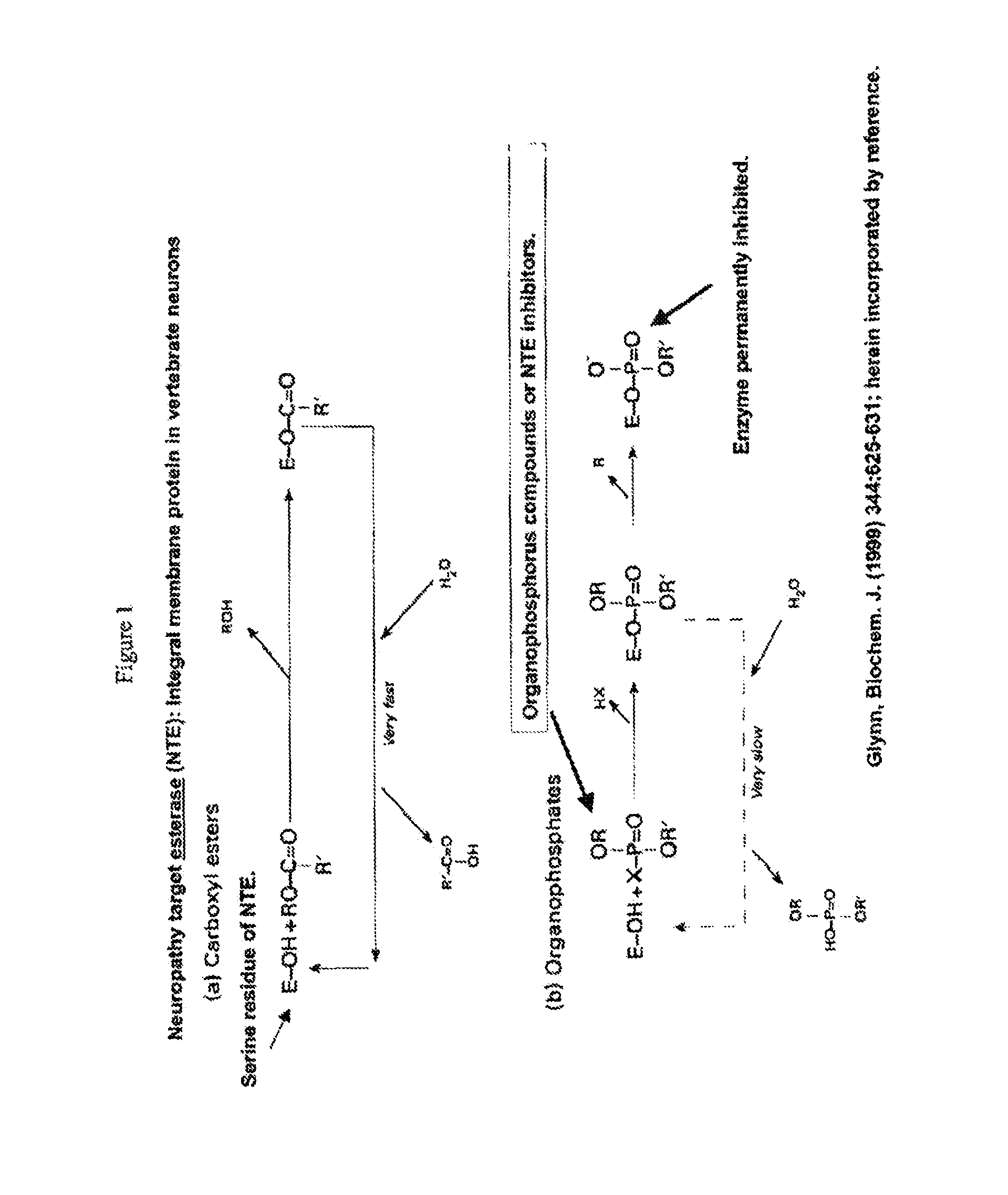Nanostructured biosensor containing neuropathy target esterase activity
a biosensor and esterase activity technology, applied in the field of nanostructured biosensors containing neuropathy target esterase activity, can solve problems such as placing the health of human population at risk, and achieve the effect of increasing the sensitivity of biosensors
- Summary
- Abstract
- Description
- Claims
- Application Information
AI Technical Summary
Benefits of technology
Problems solved by technology
Method used
Image
Examples
example i
[0248]This example provides general Materials and Methods used for construction of and testing both types of electrodes stationary (nonrotating) and electrodes capable of being rotated for providing a biosensor of the present inventions, unless otherwise noted.
[0249]Materials:
[0250]thioctic acid, poly-L-lysine (PLL) (molecular weight approximately 15,000), tyrosinase (Tyr), sodium phosphate (monobasic and dibasic), ethylenediaminetetraacetic acid (EDTA), sodium chloride, 3-[(3-cholamidopropyl)dimethylammonio]-1-propanesulfonate (CHAPS) and isopropyl thiogalactoside (IPTG), acetylcholinesterase, and butyrylcholinesterase were obtained from Sigma (St. Louis, Mo.). Ultrapure water (18.2 M·Ω) was supplied by a Nanopure-UV four-stage purifier (Barnstead International, Dubuque, Iowa); the purifier was equipped with a UV source and a final 0.2 μm filter. Mipafox was supplied by Oryza Labs.
[0251]Vectors:
[0252]The E. coli BL21(DE3) pLysS strain and pET21b vector were purchased from Novagen. ...
example ii
[0272]Expression of Full-Length NTE and NEST.
[0273]Moreover, based on the preliminary date described below, the inventor's believe this is the first demonstration of heterologous expression of a full-length, fully active NTE protein. In order to obtain this full-length functional protein, cDNA for the full-length human NTE was subcloned into plasmid pTrcHis2 / TOPO (Invitrogen) to yield plasmid pTrcHis2 / hNTE, which was then transformed into an E. coli Rosetta (DE3) expression host. The cells were grown on LB medium in shake flask to an OD600 of 1.0, and NTE expression was induced with 0.5 mM IPTG. The resulting Western blot (FIG. 2B) shows a band consistent with full-length NTE expression.
[0274]Detergent-solubilized putative NTE was affinity-purified using Ni-NTA resin and checked for phenyl valerate esterase activity. A negative control was provided using the Ni-NTA resin eluent from the cell lysate of E. coli Rosetta (DE3) cell containing pTrisHis2 / LacZ vector induced with 0.5 mM IP...
example iii
[0276]Preparation of Gold Electrode for NEST Biosensor.
[0277]The inventors produced electrodes comprising human NTE and tyrosinase. The following procedure was used to make prototype biosensors of the present inventions that have the molecular architecture shown schematically in FIGS. 3A and 4B. For example, gold electrodes (3 cm×1 cm) were cleaned in Piranha solution, dried, and then dipped in 5 mM solution of thioctic acid for 30 minutes. The electrodes were then washed with ethanol, dried under nitrogen and dipped in PLL solution in 20 mM phosphate buffer (pH 8.75) for 45 minutes. The electrodes were then rinsed with water and dipped in an aqueous solution of tyrosinase (0.2 mg / ml) for 1 hour. The last two steps of soaking and rinsing in PLL and tyrosinase were repeated 3.5 times to create 3.5 PLL-Tyr bilayers with PLL as the topmost layer. These tyrosinase electrodes were then washed with water and dipped in a solution of NEST protein (0.1 mg / ml) in 100 mM phosphate buffer, pH (...
PUM
| Property | Measurement | Unit |
|---|---|---|
| thickness | aaaaa | aaaaa |
| thickness | aaaaa | aaaaa |
| thickness | aaaaa | aaaaa |
Abstract
Description
Claims
Application Information
 Login to View More
Login to View More - R&D Engineer
- R&D Manager
- IP Professional
- Industry Leading Data Capabilities
- Powerful AI technology
- Patent DNA Extraction
Browse by: Latest US Patents, China's latest patents, Technical Efficacy Thesaurus, Application Domain, Technology Topic, Popular Technical Reports.
© 2024 PatSnap. All rights reserved.Legal|Privacy policy|Modern Slavery Act Transparency Statement|Sitemap|About US| Contact US: help@patsnap.com










